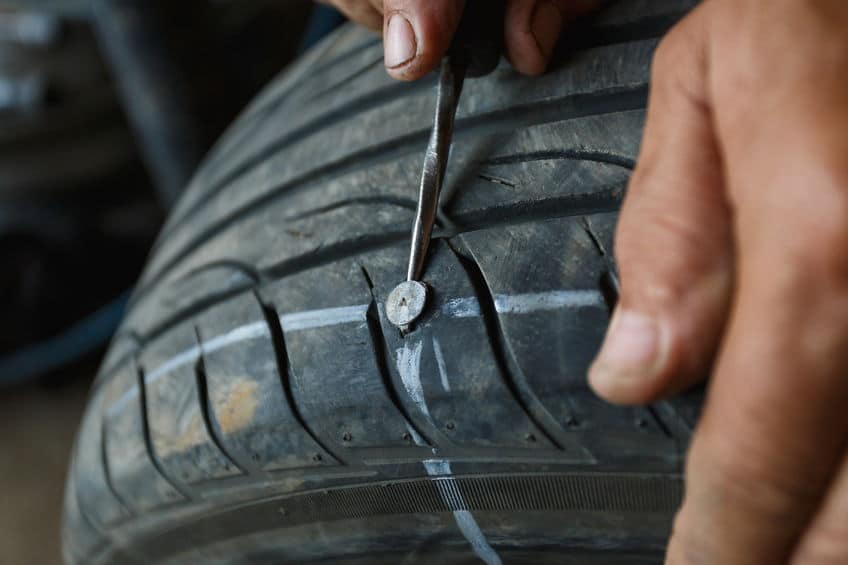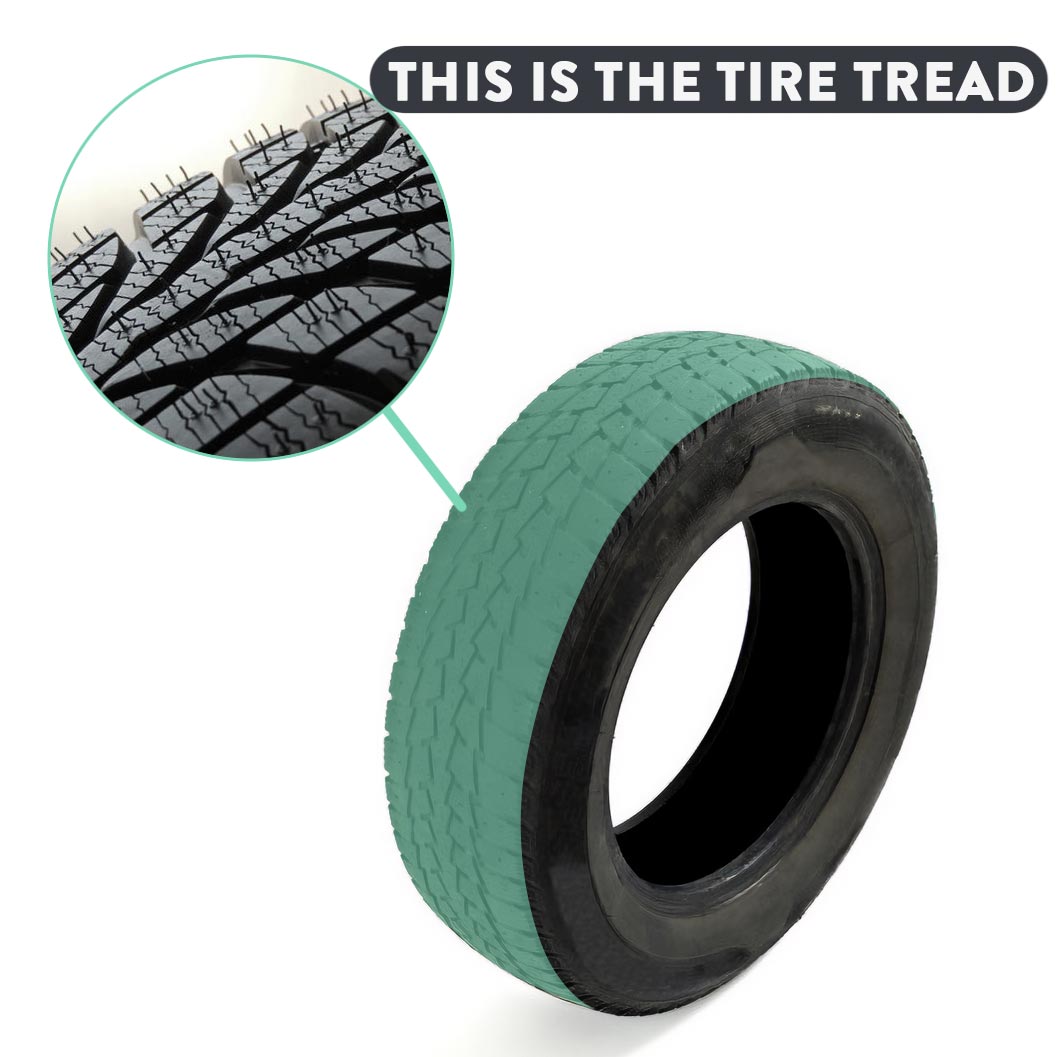The question of whether to plug or not has been debated for a long time, with some people claiming it’s unsafe to repair the tire this way. What if one of your RV’s tires gets punctured, you don’t have an extra tire, and the closest tire repair shop is miles away? Would you still plug the RV tire then?

An RV tire can be plugged provided the puncture:
- Is ¼ inch or smaller
- Is located on the tread
- Has not been repaired before using any repair method
You should detach the tire from the vehicle to inspect the damage before deciding to plug it.
While patching or plugging a trailer/RV tire can provide a temporary solution, it is important to replace the tire as soon as possible to ensure your safety.
That’s not all, as you still need to know how to plug the tire safely, any safety concerns of driving on a plugged tire, and how far you can drive with a plugged tire, which you will learn if you read on.
When can You Plug RV or Trailer Tires?
As a whole, any tire can be plugged, and RVs are not an exception. Since these vehicles are used to access some tough roads, like when camping in the woods, it’s easy for them to get punctured by objects like steel nails and sharp thorns or sticks.
While it might seem like an inexpensive way to repair the tire, it should only be done under the following circumstances:
 When the Puncture is Located on the Tread
When the Puncture is Located on the Tread

A plug will only work if the puncture is located on the tread. If the damage has occurred on the sidewall, it’s not advisable to plug since it might lead to a dangerous blowout.
If the tire has been leaking air slowly and there was no burst when the puncture occurred, there is still a chance to plug and get it back in working condition. It’s easier to plug the tread since the tire is much tougher here compared to the sidewalls.
 If the Hole is ¼ Inch or Smaller
If the Hole is ¼ Inch or Smaller
It’s far easier and safe to plug a small puncture compared to a big hole. Make sure the hole is ¼ inch or smaller, as attempting to plug anything bigger than that might result in a blowout.
If the puncture has been caused by a steel nail or anything of its equivalent diameter, it’s safe to plug it since steel nails have a diameter measuring less than a ¼ inch.

 If the Area Punctured Has Not Been Repaired Before
If the Area Punctured Has Not Been Repaired Before
Tire repairs should never overlap. It’s the RV cardinal rule that experienced tire repair shops follow and is not an exception here.
It’s easy to completely ruin the tire if you attempt to plug an area that has been repaired before since this part of the tire is considered vulnerable. You also risk interfering with the repair job, which might end up exposing the previous puncture.
Knowing Which Class of RV to Plug
While it’s easy to plug any tire, it’s also best to know that some tires might pose more challenges when plugging than others. In this case, the Class A RV tires are a bit challenging to plug due to reasons such as:
- The tire supports around 30,000 pounds of weight. Such weight might put too much pressure on the plug, which might not hold for too long.
- Some Class A RVs have huge and heavy tires, making it hard to change them, let alone plugging a puncture on one of them.
Although not popularly used, Class C+ RVs can also pose the same challenges as Class A. On the other hand, Classes B and C are easier to plug and won’t require much effort.
![]() Personal tips: Before plugging any tire, it’s best to completely detach the tire from the vehicle and inspect the nature of the puncture.
Personal tips: Before plugging any tire, it’s best to completely detach the tire from the vehicle and inspect the nature of the puncture.
What Potential Risks Should You Expect When You Plug An RV Tire?
Plugging any tire should be the last resort and a temporary puncture repair. To make sure it’s done correctly, plugging an RV tire should only be done by someone with enough experience.
However, there are still some safety risks associated with plugging an RV tire, regardless of whether you have done this before. They include:
- The tire blowing out – Attempting to plug a puncture can lead to a total blowout, damaging the whole tire. Make sure this is a risk you’re willing to take.
- Unstable driving – It’s common for people to avoid filling the tire with air to maximum capacity when they have plugged it. They’re usually worried about putting too much pressure on the tire, which might end up ripping the plug or causing a blowout. This often leads to erratic driving.
Plugging is a temporary puncture fix and should only be done to help you reach the nearest tire repair center. It’s critical to replace the tire as soon as possible.
How Do You Plug An RV Tire?
The process of plugging a tire is not rocket science, and you can manage this task within a few minutes.
Not only will it save you around $20, but the time you might have to wait for the repair shop to send someone over. You need a few tools, with most of them already available in your RV:
- Wire cutters
- Spray bottle
- RV jack
- Tire plugging kit
- Pliers
- Tire sealing cement
- Soap and water solution
- Paper towels
- Tire plug strip
- Air pump
After detaching the tire from the RV, ensure you support the vehicle firmly with an RV jack. Then:
- Identify the leak in your tire. You can do so by pumping the tire until you can’t press it with your finger.
- Pour a mixture of soap and water into the spray bottle and spray it all over the tire while checking for any bubbles, which will indicate the leaking point.
- Once you find the source of the air leak, check what has pierced the tire and use the pliers to remove it.
- You now need to widen the hole to prepare it for plugging. You can do this by jamming the T-handle reaming tool into the hole. Don’t worry about widening the hole since the T-handle reaming tool is less than ¼ inch in diameter.
- If the hole is too small for the T-handle tool to go through, try using the hand-held drill with a smaller diameter than the T-handle tool.
- Next, take out the plug strip and the plug insertion tool. Thread the strip through the “eye” of the insertion tool until both sides are equal. Dip the strip into the tire sealing cement to coat it all.
- Press the plug insertion tool containing the plug strip through the hole in the tire. Make sure only an inch is visible. Pull up the handle of the insertion tool gently, leaving the plug strip in the hole.
- Fill the tire with air but not to maximum capacity. It’s best to leave it at least 10% below the recommended air level. Pour soapy water on the plugged area to determine if the puncture is fully sealed.
Use wire cutters to trim off the excess plug strip, and the tire is ready to use.
How Far Can You Drive With A Plugged RV Tire?
Plugged tires can last longer depending on how well you have sealed the puncture, the weight of the RV, and the road you’re traveling on. It’s easy to drive for miles or even years on a plugged tire.
However, it’s best to allow a tire repair expert to check the plugged area once you’ve reached a tire repair center to determine whether more work is required.
Conclusion
Plugging is an effective puncture repair process that might save you time, especially when you’re stranded far from the nearest town. It should only be done if the hole is ¼ inch or smaller and when the puncture is located on the tread. You shouldn’t plug an already repaired area. Class A RVs are the hardest to plug, with Classes B and C being the easiest. You can drive for many miles with a properly plugged tire.
